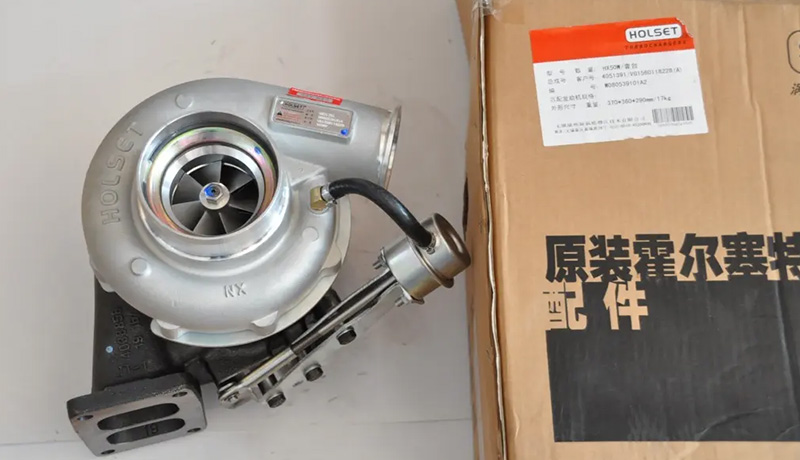Categories
- Blog (58)
- News & Events (34)

Phenomenon One: Holset turbocharger spill
Phenomenon 1: oil consumption is large, but the exhaust smoke is normal, and the power is not reduced.
Reason: This situation is generally caused by oil leakage.
Treatment methods:
1. First of all, check the engine lubrication system external tubing (including the turbocharger inlet and return tubing) whether oil leakage;
2. Check whether there is oil at the exhaust outlet of the supercharger. If there is oil, it can be judged that the sealing ring at one end of the turbine is damaged, and the sealing ring should be replaced.
Phenomenon two: Holset turbocharger oil consumption, exhaust blue smoke, but the power does not decline.
Cause: Due to oil leakage at the pressure end of the supercharger, oil is burned through the engine intake pipe into the combustion chamber, there are the following possibilities:
1. The return pipe of the supercharger is not smooth, and the oil in the middle support of the rotor assembly is left too much, flowing into the compressor impeller along the rotor shaft.
2. After the sealing ring or oil dumping ring near one end of the compressor impeller is damaged, the oil enters the impeller chamber, and then goes into the combustion chamber with the air after indoor pressurization.
Treatment methods:
1. Open the compressor outlet or engine intake straight pipe (rubber hose), watch the mouth, pipe wall adhesion oil. If yes, please check whether the turbocharger return pipe is unblocked. If it is not smooth, it is caused by excessive accumulation of oil at the middle support, and the return pipe should be dredged and installed.
2. If smooth, it is caused by damage to the sealing ring or oil ring at one end of the impeller, which should be repaired by disassembling the turbocharger.
Phenomenon three: large oil consumption, exhaust blue smoke or black smoke, and power decline.
The reason:
1. The gap between the piston and cylinder was too frayed and the oil was burned off by rushing into the combustion chamber.
2. Air in the process of being inhaled by the supercharger, the air flow encounters greater resistance. (such as air filter block, intake hose suction deformation or flattening), compressor inlet pressure is low, resulting in oil leakage into the compressor, with compressed air into the combustion chamber to burn.
Treatment methods:
1. Check whether there is oil in the wall of the inlet straight flexible pipe, whether it is flattened, so that the air flow is blocked or the air filter element is blocked.
2. If there is oil in the pipe mouth and wall, the air filter element should be cleaned or replaced.
There was a grinding sound of metal
Phenomenon: exhaust black smoke, power decline, and the supercharger has abnormal sound.
The reason:
1. If there is metal friction sound, it is the turbocharger rotor bearing or thrust bearing wear too much, impeller and turbocharger shell friction.
2. If it is not the sound of metal friction, but the sound of air flow, it is due to the high-speed rotation of the turbocharger rotor, the rotating sound, or the leakage phenomenon caused by the inlet and exhaust interface due to poor connection.
Treatment methods:
(1) The former should be repaired by replacing the damaged spare parts according to the wear condition.
2. The latter should be seriously distinguished, targeted solution.
Tuborcharger bearing damage
Phenomenon: supercharger bearing damage, engine power decline, high oil consumption, black smoke, serious when the supercharger can not work.
The reason:
1. Insufficient lubricating oil pressure and flow.
A. Insufficient supply of lubricating oil for turbocharger journal and thrust bearing;
B. Insufficient lubricating oil to keep floating between rotor journal and bearing;
C. The supercharger has been running at high speed, and the lubricating oil is not supplied in time.
2. Debris or sediment into the lubrication system.
3. Oil oxidation deterioration.
A. Diesel oil overheating, too much gas channeling between the piston and the cylinder wall;
B. cooling water leakage into the oil;
C. Improper oil selection and failure to change oil regularly as required.
Treatment methods:
1. Check whether the lubricating oil pressure is normal and the oil quantity meets the requirements.
2. According to the requirements of the regulation, regularly change the lubricating oil, and ensure that the lubricating oil clean.
3. Strictly according to the requirements of the provisions, the use of lubricating oil, not mixed.
4. Avoid the engine working at high temperature and keep the normal working temperature of the engine.
